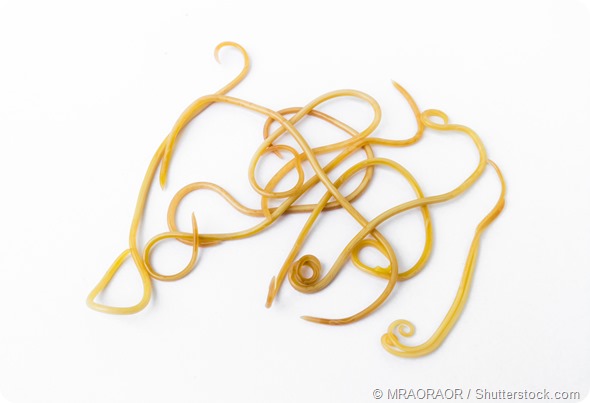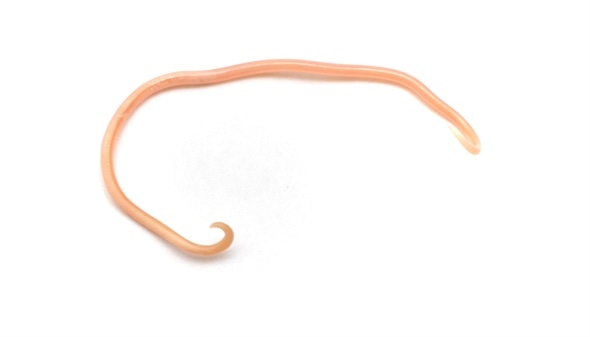Roundworm infection, or toxocariasis, is a zoonotic disease — a disease that can be transmitted from animals to humans. Dogs and cats are the definitive hosts for the roundworm species that commonly cause human disease.
Roundworm life cycle
A roundworm is a type of nematode (ascarid) that reproduces in the intestinal tract of its host. Dogs are the host for Toxocara canis, and cats are the host for Toxocara cati. Those species are present in every part of the world, due to the global population of dogs and cats. Toxocara canis is more frequently a cause of human infection than Toxocara cati.

Helminthiasis Toxocara canis - also known as dog roundworm.
The life cycle of the roundworm begins when eggs are passed with feces and deposited in the soil. It takes two to four weeks for the eggs to become infectious. A new host is infected by ingesting the eggs. The eggs hatch, releasing larvae that penetrate the walls of the small intestine and enter the bloodstream. The larvae can travel to organs throughout the body from the blood.
In its natural host, the roundworm completes its life cycle by returning to the small intestine and developing into adult worms. The process takes about 60 to 90 days after hatching. The worms then mate and produce eggs that are excreted in the feces, beginning the cycle anew. The incubation period can be extended in lower temperatures, and in northern climates, the eggs may remain dormant through the winter.
Human infection
Humans are not the natural host for Toxocara canis and Toxocara cati. There is a human roundworm, Ascaris lumbricoides, but infection with that parasite is not as common as infection with cat and dog roundworm, as it occurs mainly in regions with poor sanitation.

© Marcel Jancovic / Shutterstock.com
If humans ingest the larvae of cat or dog roundworm, they can become infected, and illness results from the larvae migrating through organs and tissues. Ocular larva migrans (OLM) is an illness that results when the larva invade the eye. OLM can lead to blindness. Visceral larva migrans (VLM) is the illness caused by roundworm larva in the organs or central nervous system.
The larvae do not mature to adult worms and reproduce in humans; so humans don't spread the infection to each other.
Transmission through pets
Toxocara can also be spread by other animals called paratenic hosts. Eggs consumed by another animal, such as a rodent, can hatch and produce larvae that continue their development into adult worms when consumed by the primary host—a cat or a dog.
In puppies, the T. canis completes its life cycle with production of new eggs by adult worms. In older dogs, however, the process arrests at the second of four larval stages, and the larvae persist in the host for long periods of time. Unless dogs are kept in a toxocara-free environment, they quickly become infected again.
During pregnancy, larvae become reactivated and migrate through the placenta to infect the fetus. For this reason, puppies are usually born with toxocara infection, and are thus at high risk of transmitting the worms to humans if they are not treated.
Toxocara can also be passed to puppies or kittens through the mother's milk. A more common source of infection for humans—usually children—is soil contaminated with toxocara eggs.
Good hygiene, regular de-worming of pet dogs and cats, and keeping dogs and cats out of children's play areas are important precautions to reduce transmission of toxocara roundworms to humans.
Further Reading
Last Updated: Dec 29, 2022